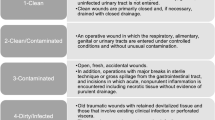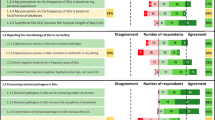Abstract
Introduction: The German national nosocomial infections surveillance system (KISS) has been collecting surveillance data from hip and knee prosthesis operations since 1997. The purpose of this article is to investigate whether surveillance and feedback of surgical site infection (SSI) information to the physicians and nurses of participating hospitals lead to reduced SSI rates or not. Materials and methods: Only information from hospitals previously participating for at least 3 years was used for the analysis. Monthly SSI rates were pooled over the 36-month period, beginning in each clinic’s case with its first month of participation, the rates then being compared for 12-month periods. Relative risks were calculated for comparison of the SSI rates in the first and third years of participation. A multiple logistic regression analysis with stepwise variable selection was performed to identify significant risk factors, including the year of surveillance after starting surveillance activities. Results: The overall SSI rates were 1.4% for hip prosthesis and 1.0% for knee prosthesis. Fourteen clinics participated in KISS for at least 3 years continuously with HIP prostheses and 21 with knee prostheses. It was possible to include a total of 15,457 hip and 9,011 knee procedures for this analysis. A comparison of data from the first and the third years show a significant SSI reduction with hip procedures, with a relative risk of 0.54 (CI95 0.38–0.77), and a trend towards reduced SSI rates for knee procedures. The multiple logistic regression analysis confirmed that the SSI rate for hip prosthesis was significantly lower in the third year than in the first year of surveillance (OR=0.57; CI95 0.42–0.78), though for knee prosthesis the level of significance was not achieved. Conclusion: A reduction of SSIs following hip and knee prosthesis operations through the introduction of ongoing surveillance and the possibility of using benchmark data for comparison does seem to be possible in many institutions.
Similar content being viewed by others
References
Anonym (2003) Surveillance des infections du site opératoire en France en 1999 et 2000—Résultats. In: Institut de VeilleSanitaire—Départment des maladies infectieuses
Anonymous (2003) Surveillance of surgical site infections in English hospitals 1997–2002. In: Health Protection Agency
Ayliffe GAJ (1986) Nosocomial infection—the irreducible minimum. Infect Control 7:92
Borst M, Coillier C, Miller D (1986) Operating room surveillance: a new approach in reducing hip and knee prosthetic wound infections. Am J Infect Control 14:161
Coello R, Gastmeier P, De Boer A (2001) Surveillance of hospital-acquired infection in England, Germany, and the Netherlands: will international comparison of rates be possible? Infect Control Hosp Epidemiol 22:393
de Boer A, Geubbels E, Wille J et al (2001) Risk assessment for surgical site infections following total hip and total knee protheses. J Chemother 1:42
Douglas P, Asimus M, Swan J et al (2001) Prevention of orthopaedic wound infections: a quality improvement project. J Qual Clin Pract 21:149
Emori TG, Culver DH, Horan TC et al (1991) National Nosocomial Infection Surveillance system (NNIS): description of surveillance methodology. Am J Infect Control 19:19
Fishmen D, Reilly D, Karchmer A et al (2001) Clinical effectiveness and cost-effectiveness of two management strategies for infected total hip arthroplasty in the elderly. Clin Infect Dis 32:419
Gastmeier P, Geffers C, Sohr D et al (2003) Five years working with the German nosocomial infection surveillance system KISS. Am J Infect Control 31:316
Gastmeier P, Sohr D, Just H-M et al (2000) How to survey nosocomial infections? Infect Control Hosp Epidemiol 21:366
Gaynes R, Culver D, Horan T et al (2000) Surgical site infection (SSI) rates in the US, 1992–1998: the National Nosocomial Infections Surveillance system basic SSI risk index. Clin Infect Dis 33:S69
Geubbles E, Mintjes-de Groot A, Wille J et al (2000) PREZIES: PREventie van ZIEkenhuisinfecties door Surveillance. Component postoperatieve wondinfecties III, 1997–1999. In: Bilthoven, RIVM
Haley RW, Culver DH, White JW et al (1985) The efficacy of infection control programs in preventing nosocomial infections in US hospitals. Am J Epidemiol 212:182
Horan TC, Gaynes RP, Martone WJ et al (1992) CDC definitions of surgical site infections: a modification of CDC definitions of surgical wound infections. Infect Control Hosp Epidemiol 13:606
Lentino J (2003) Prosthetic joint infections: bane of orthopedists, challenge for infectious disease specialists. Clin Infect Dis 36:1157
Lidgren L (2001) Joint prosthestic infections: a success story. Acta Orthop Scand 72:553
National Nosocomial Infections Surveillance (NNIS) system (2003) National Nosocomial Infections Surveillance (NNIS) system report, data summary from January 1992 to June 2003, issued August 2003. Am J Infect Control 31:481
Peersman G, Laskin R, Davis J et al (2001) Infection in total knee replacement. Clin Orthop Relat Res 392:15
Schneeberger P, Smits M, Zick R et al (2002) Surveillance as a starting point to reduce surgical-site infection rates in elective orthopaedic surgery. J Hosp Infect 51:179
Sculco T (1995) The economic impact of infected joint arthroplasty. Orthopedics 18:871
Whitehouse J, Friedman N, Kirkland K et al (2002) The impact of surgical-site infections following orthopaedic surgery at a community hospital and a university hospital: adverse quality of life, excess length of stay, and extra costs. Infect Control Hosp Epidemiol 23:183
Author information
Authors and Affiliations
Corresponding author
Rights and permissions
About this article
Cite this article
Gastmeier, P., Sohr, D., Brandt, C. et al. Reduction of orthopaedic wound infections in 21 hospitals. Arch Orthop Trauma Surg 125, 526–530 (2005). https://doi.org/10.1007/s00402-005-0036-y
Received:
Published:
Issue Date:
DOI: https://doi.org/10.1007/s00402-005-0036-y




